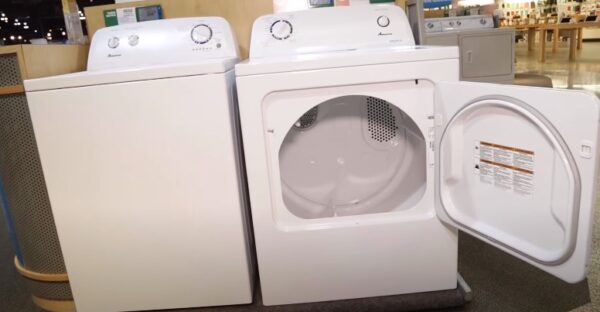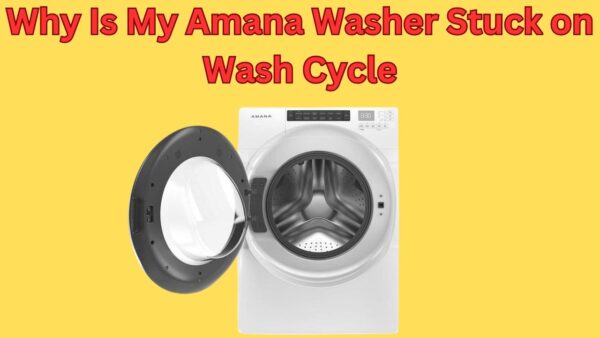Dirty water left in your washing machine can not only be unsightly, but it can also cause unpleasant odors and even lead to operational issues.
If you’ve noticed a puddle of water that refuses to drain, you don’t have to panic.
There are several simple and effective ways to get rid of this standing water and restore your washing machine to its optimal functionality.
In this guide, we will walk you through the 10 best ways to solve this common household problem.
How to Get Rid of Dirty Water in Washing Machine

1. Check and Clean the Drain Hose
Firstly, locate the drain hose at the back of your washing machine. This is usually a flexible plastic pipe that drains out dirty water.
Disconnect the hose carefully from the machine, and make sure to have a bucket or towels handy to catch any water that may spill.
Once the hose is disconnected, use a long brush or a straightened wire hanger to carefully remove any blockages inside the hose.
Finally, rinse the hose with warm water to dislodge any leftover debris. Remember, a clogged hose is often the culprit for dirty water remaining in your washing machine.
2. Inspect the Washing Machine Pump for Blockages
To inspect the washing machine pump for blockages, first, ensure that you’ve disconnected the machine from the power source.
This is a vital safety step that should never be overlooked. Then, locate the pump – typically, it’s at the base of the machine, though this may vary depending on the model.
Gently remove the pump, being careful not to damage any attached hoses. Once you’ve removed the pump, inspect it for any obvious blockages – these could be small items that have accidentally been left in pockets, like coins or tissues, or build-ups of lint and fabric.
After identifying the blockage, carefully remove it and clean the pump thoroughly before reinstalling it. After the pump is back in place, run a short wash cycle to ensure that the machine is now draining correctly. If you still encounter issues, it may be time to consult a professional.
3. Examine the Water-Level Control
The water-level control in your washing machine is an essential component that regulates the amount of water in the tub during each cycle.
It’s usually a pressure system that measures the weight of the water and adjusts it as needed. If you notice that your washing machine is retaining dirty water, this could be indicative of a problem with the water-level control.
Firstly, you need to locate this control, which is usually found in the control panel of the washing machine.
Once you have located it, check for any visible issues such as a loose or damaged tube. If everything seems intact, consider testing the control with a multimeter to ensure it’s functioning correctly.
A faulty water-level control can lead to inadequate or excess water levels, resulting in poor washing performance and dirty water retention.
4. Thoroughly Clean the Lint Filter
The lint filter in your washing machine plays a critical role in the prevention of dirty water buildup.
Over time, it can become clogged with lint, hair, and detergent residue, which can restrict the flow of water and lead to the accumulation of dirty water.
It’s advisable to clean the lint filter regularly to ensure optimal performance of your washing machine. Begin by locating the filter, which is typically found along the top rim or at the bottom of the drum.
Remove any visible lint and then, using a soft scrub brush and a mild detergent, gently clean the filter.
Rinse thoroughly to ensure all debris has been removed. This simple maintenance task can greatly improve the cleanliness of your wash water, leading to fresher, cleaner laundry.
5. Unclog the Drain Pipe
The first step to unclog your washing machine’s drain pipe is to locate it. Typically, it’s a large plastic hose attached to the back of the machine.
Once located, use a plumber’s snake or a straightened wire hanger to gently push through and dislodge any blockages.
Be careful not to push too hard as you could damage the pipe. If this doesn’t work, you may need to detach the pipe from the machine for a more thorough clean.
Remember to put a bucket beneath the pipe to catch any water that might spill out. Finally, reattach the pipe and run a rinse cycle to ensure the water drains properly. If it doesn’t, it might be time to call in a professional.
6. Reset the Washing Machine
Resetting your washing machine can often fix the problem of dirty water. Unplug the machine, wait for about a minute, then plug it back in.
Some washing machines have a specific reset button, which should be pressed to reinitialize the system.
This process forces the machine to check all its various components for any faults or clogs, including the draining system which could be causing the dirty water issue.
If the machine finds any issues, it may automatically rectify them or alert you to the problem.
Remember, always refer to your washing machine’s user manual for specific resetting instructions, as the procedure can vary between different models.
7. Inspect for Leaks in the Washing Machine
To inspect for leaks in the washing machine, start by examining the hoses and fittings that connect the machine to the water supply.
Check for signs of wetness, dripping, or even a pool of water under the machine. If the hoses are the source of the leak, they can often be replaced relatively easily.
Also, pay close attention to the seal around the door of front-loading machines, as this is a common area for leaks to occur. If the door seal is damaged, it may need to be replaced to ensure a proper, tight fit when the door is closed.
Regularly checking these areas can prevent further damage and help keep your machine running efficiently.
8. Examine the Door Seal of the Machine
The door seal, also known as a gasket, is a vital component in ensuring the proper functioning of your washing machine.
Over time, debris, detergent residue, and excess water can accumulate in this seal, leading to unpleasant odors and murky water.
Inspect the seal regularly for any signs of blockage or damage. If you find a buildup of dirt or grime, clean it thoroughly with a household cleaner and a soft cloth.
In case of any physical damage to the seal, it’s recommended to replace it to avoid any further issues.
9. Perform a Washing Machine Maintenance Wash
Performing a maintenance wash is an effective method to get rid of dirty water and any lingering odors in your washing machine.
It involves running a cycle without any clothes — an ’empty load’ — at the highest temperature setting.
This high-heat cycle can kill bacteria and break down built-up grime inside the drum and pipes. Make sure to use a washing machine cleaner specifically designed for this purpose or a natural alternative like baking soda and vinegar.
Always remember to leave the machine door open after the cycle to allow it to dry fully.
This simple routine can greatly enhance the longevity and efficiency of your washing machine, ensuring your clothes come out clean every time.
10. Consult With a Professional Appliance Technician
If the issue persists despite your best efforts, it’s advisable to consult with a professional appliance technician.
These experts possess the necessary skills and equipment to accurately diagnose and fix the problem.
They are well-versed in dealing with various washing machine models and can provide the best possible solution. A skilled technician will be able to determine if it’s a simple blockage, a pump issue, or a more complex mechanical problem.
Relying on their expertise not only ensures correct diagnosis and repair but also prevents further damage that might result from incorrect self-diagnosis and repair attempts.
Conclusion
Dealing with dirty water in your washing machine can be a daunting task, but there are several steps you can take to troubleshoot and fix the problem.
Start by checking the hoses and filters for blockages, making sure to clean them regularly. If this doesn’t work, consider if the issue might be with your detergent or water supply.
However, if the issue continues to persist, it may be time to call in the professionals. Remember, a professional appliance technician has the knowledge and tools to diagnose and fix the problem effectively.
Taking these measures can help ensure that your washing machine runs efficiently and continues to provide clean, fresh clothes for you and your family.
FAQs
How do you clean dirty water out of a washing machine?
To clean dirty water out of a washing machine, first run a cycle with a washing machine cleaner or a homemade solution of vinegar and baking soda.
Then, check and clean the filter and hoses for any blockages or debris that may be causing the problem.
Why is dirty water coming into my washing machine?
Dirty water may be coming into your washing machine because of a backflow issue or a blockage in the drain hose that’s causing dirty water to be siphoned back into the machine.
Can dirty water damage the washing machine?
Yes, dirty water can damage a washing machine. The contaminants in the dirty water may clog the machine’s filters and hoses or cause corrosion on its metal parts, leading to operational issues.
Why is my washing machine filling up with smelly water?
Your washing machine may be filling up with smelly water due to a buildup of bacteria or mold in the drum or drain hose, giving off a foul odor.
Regular cleaning and maintenance is key to preventing this issue.
Indesit Washing Machine Won T Start Cycle
Indesit IWDE126 Door Wont Open
How to Prevent Clothes From Getting Stuck Under Agitator
Washing Machine Will Not Agitate but Will Spin and Drain


